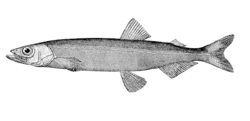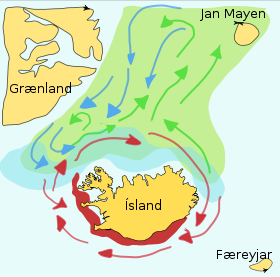- Capelin
-
This article is about the fish. For the plant genus, see Mallotus (plant).
Capelin 
Scientific classification Kingdom: Animalia Phylum: Chordata Class: Actinopterygii Order: Osmeriformes Family: Osmeridae Genus: Mallotus Species: M. villosus Binomial name Mallotus villosus
Müller, 1776The capelin or caplin, Mallotus villosus, is a small forage fish of the smelt family found in the Atlantic and Arctic oceans. In summer, it grazes on dense swarms of plankton at the edge of the ice shelf. Larger capelin also eat a great deal of krill and other crustaceans. Whales, seals, cod, squid, mackerel, beluga whales and seabirds all prey on capelin in particular during the spawning season of the capelin while it migrates southwards. Capelin spawn on sandy beaches and sandy bottom at the age of 2–6 years, and have an extremely high mortality rate on the beaches after spawning, for males close to 100% mortality.[clarification needed]
 Capelin on an Icelandic coin.
Capelin on an Icelandic coin.
Males reach 20 cm in length, while females are up to 25 cm long. They are olive-colored dorsally, shading to silver on sides. Males have a translucent ridge on both sides of their bodies. The ventral aspects of the males iridesce reddish at the time of spawn.
In years with large quantities of herring in the Barents Sea, capelin seem to be heavily affected. Probably both food competition and herring feeding on capelin larvae lead to collapses in the capelin stock.
Commercially, capelin is used for fish meal and oil industry products, but is also appreciated as food. The flesh is agreeable in flavor, resembling herring. Capelin roe ("masago") is considered as a high value product. It is also commonly mixed with wasabi and sold as "wasabi caviar". Sometimes masago is used as a substitute for tobiko, flying fish roe, due to its similarity and taste.
Capelin is an important forage fish, and is essential as the key food of the Atlantic cod. The North-East Atlantic Cod and Capelin fisheries therefore are managed by a multi-species approach developed by the main resource owners Norway and Russia.
In the provinces of Quebec (particularly in the Gaspé peninsula) and Newfoundland and Labrador in Canada, it is a regular summertime practice to go to the beach and scoop the capelin up in nets or whatever is available, as the capelin "roll in" in the millions each year at the end of June or in early July.
Capelin migration
 Distribution and migration of Icelandic capelin
Distribution and migration of Icelandic capelin
Green shade: Feeding area of adults
Blue shade: Distribution of juveniles
Green arrows: Feeding migrations
Blue arrows: Return migrations
Red shade and Red arrows: Spawning migrations – Main spawning grounds and larval drift routesCapelin move inshore in large schools to spawn and migrate in spring and summer to feed in the plankton-rich oceanic area between Iceland, Greenland, and Jan Mayen. Capelin distribution and migration is linked with ocean currents and water masses. Around Iceland, maturing capelin usually undertake extensive northward feeding migrations in spring and summer and the return migration takes place in September to November. The spawning migration starts from north of Iceland in December to January. In a paper published in 2009, researchers from Iceland recount their application of an interacting particle model to the capelin stock around Iceland, successfully predicting the spawning migration route for 2008.[1]
Notes
- ^ Barbaro1 A, Einarsson B, Birnir1 B, Sigurðsson S, Valdimarsson S, Pálsson ÓK, Sveinbjörnsson S and Sigurðsson P (2009) "Modelling and simulations of the migration of pelagic fish" Journal of Marine Science, 66(5):826–838.
References
- "Mallotus villosus". Integrated Taxonomic Information System. http://www.itis.gov/servlet/SingleRpt/SingleRpt?search_topic=TSN&search_value=162035. Retrieved 11 March 2006.
- Froese, Rainer, and Daniel Pauly, eds. (2005). "Mallotus villosus" in FishBase. 10 2005 version.
- Capelin off Iceland: Biology, exploitation and management
- This article incorporates text from the public domain 1911 edition of The Grocer's Encyclopedia.
Principal commercial fishery species groups Wild Forage fishOther wild fishMolluscs- Sea cucumbers
- Sea urchin
- more...



Farmed Categories:- Osmeridae
- Commercial fish
- Greenlandic cuisine
Wikimedia Foundation. 2010.
